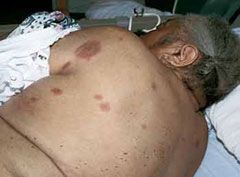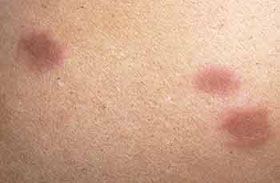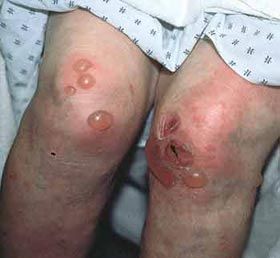Octogenarian With New Rash
An 89-year-old woman is seen for a rash on her back of 2 days' duration. Has Broca aphasia and dense right hemiparesis from an old stroke; remains highly communicative without words, and interactive, in the nursing home where she lives. Long-standing diabetes mellitus and hypertension contributed to the stroke and to marked peripheral arterial disease.
This article was originally presented as an independent educational activity under the direction of CME LLC. The ability to receive CME credits has expired. The article is now presented here for your reference. CME LLC is no longer responsible for the presentation of the article.

HISTORY
An 89-year-old woman is seen for a rash on her back of 2 days' duration. Has Broca aphasia and dense right hemiparesis from an old stroke; remains highly communicative without words, and interactive, in the nursing home where she lives. Long-standing diabetes mellitus and hypertension contributed to the stroke and to marked peripheral arterial disease.
Devoted husband and highly observant certified nursing assistant (CNA) note no change in demeanor, and no evidence of pruritus. No new topical or oral medicines, soaps, or clothing.
MORE HISTORY/PHYSICAL
Ebullient woman who takes great pleasure in all human interactions. Expressive facial movements; uses these to deny, convincingly, any discomfort. Vital signs normal. Skin over back and left posterior axilla: multiple nontender lesions, the largest several centimeters across, round (coinlike). No lesions in mouth or elsewhere on skin and nails. No involvement at healed scar of remote right above-knee amputation. Obese, with pendulous breasts and abdomen.
WHAT'S YOUR DIAGNOSIS?
• Bullous Pemphigoid
• Erythema Multiforme
• Idiopathic Urticaria
• Nummular Tinea(Answer on next page.)

Figure 1 –Bullous pemphigoid lesions on this patient’s back are seen close up. These brownish red to violaceous lesions are minimally elevated beneath an apparently intact epidermal surface. Character suggests noninfectious inflammatory infiltration rather than urticaria.
ANSWER: BULLOUS PEMPHIGOID
At first I did not recognize these lesions. One of them made me think of a target lesion of erythema multiforme simply because it was larger than the others. But it lacked the central clearing that would be the hallmark and is the basis for the other name of a target lesion, namely "iris lesion." I stopped several medicines and changed others to putatively less immunogenic alternatives. At the same time, I ordered topical antifungals for what I called, with no basis for doing so, "nummular tinea." These changes did not produce any improvement.
A few days later, the excellent CNA who attended the woman pointed out a tiny blister in the center of the largest lesion. The CNA noticed this vesiculobulla when bathing the patient. Over the next few days, large tense bullae emerged. At that point, the clinical diagnosis of bullous pemphigoid emerged much more clearly.
Subsequent dermatologic consultation, biopsy with immunopathologic study, and serologic studies corroborated the diagnosis. Meanwhile, new lesions appeared over the wrists, forearms, abdomen, and anterior thorax; a related blood eosinophilia was documented.
CASE DISCUSSIONProdrome and Variants
Most nondermatologists think of bullous pemphigoid exclusively as intact tense bullae. We may recall that bullous pemphigoid is distinguished clinically from its more lethal cousin, pemphigus vulgaris, in part because pemphigus does not typically produce intact bullae--just circular erosions and ragged remnants of ruptured bullae.1 Involvement of oral mucous membrane can occur in either disorder, but is noted more often, earlier in the course, and with greater severity in pemphigus vulgaris.

Figure 2 –Another case of biopsy proven bullous pemphigoid. All that can be seen are generalized erythema and excoriations leading to shallow erosions.
At the time this photograph was taken, the patient did not have any bullae or vesicles (Figure 1). The lesions are urticarial, although they look rather flatter and darker than the more familiar lesions of idiopathic urticaria. Such nonbullous lesions are regularly--but not invariably--seen in the early phase of bullous pemphigoid.2,3
The degree of pruritus associated with bullous pemphigoid varies from nil, as in this instance, to severe. The worst pruritus can lead to excoriation of lesions, as seen in another patient I treated a month earlier (Figure 2), which manifested exclusively as a large bulla on the sole and numerous utterly nonspecific excoriations on the shins. Localized bullous pemphigoid poses a major diagnostic challenge,4 especially inasmuch as the familiar tense bulla (Figure 3) does not exclude diabetic dermopathy,5 diaper rash, shear injury, and allergic contact dermatitis. Some papers about bullous pemphigoid have used inadequate diagnostic standards, further muddying the waters.6
Lesions of bullous pemphigoid develop over time. Early in the course, the patient may have no bullae. In addition, a few patients never demonstrate any bullae at all, despite immunopathologic and other findings that confirm the diagnosis.3 Such cases would defy diagnosis by generalists. However, the concept of bullous pemphigoid in a prebullous phase can be brought to bear successfully by the primary care physician confronted with an older patient who has either unrecognizable skin lesions, progressive urticaria of unknown cause, or unexplained pruritus. Of course, pruritus in aged patients most often results from dry skin, with far fewer cases attributable to other skin disorders, to cholestasis, or to psychogenic disorders.
Classic Lesions
Bullae in bullous pemphigoid tend to preferentially affect the limbs; in our index case, the distal part of the left leg never had lesions. Extensive erythema developed on the right thigh stump and appeared more infiltrative than urticarial. Worsening of these lesions paralleled the flare-up of bullae elsewhere. The raised area was not cellulitic,7 and it resolved with high-dose corticosteroid therapy without antibiotics.

Figure 3 –– A third case of bullous pemphigoid, with more classic appearance of tense bullae and 1 flaccid postaspiration.
Several large areas of erythema and erosion led to peeling-back of the skin. These included a lesion on the anterior abdomen that began as a large bulla that quickly ruptured, eroded in part because of some maceration from pendulous abdominal folds, and then reepithelialized, principally from the hair follicles. Prominent postinflammatory hyperpigmentation followed.
Over the patient's paretic right wrist, a bulla had formed at the edge of reddened skin that was inflamed from the pemphigoid. The bulla subsequently ruptured. Here the course of peeling, regeneration of intact skin, and fading of both erythema and hyperpigmentation was slower than on the abdomen. The perineum was spared altogether, as were the solitary foot and the hands.
Assessment of an Aphasic and Hemiparetic Patient
Although this woman made only rudimentary speech sounds, she used her superbly expressive face to indicate symptoms and concerns. Her husband interpreted further, drawing on decades of marriage to make better inferences than the physicians and nurses could.
The absence of excoriation could not be used to infer an absence of pruritus. This woman had lesions in an area that would be accessible to scratching only by her right hand-which was paretic. However, she was not observed to rub her back against bedclothes or other objects, nor did she indicate any desire for another person to scratch the area. Our inference was corroborated by her shaking her head when asked if the lesions were at all itchy.
The case illustrates, yet again, how vital it is that we use creativity and reasoning in making bedside assessment of the patient who cannot tell us in words--our most potent diagnostic tools--what is amiss.
Drug-induced Pemphigoid and the Cancer Connection
Because bullous pemphigoid occurs primarily in persons older than 60 years, and because this is the age range with the highest incidence of cancer, there have been reports of an association. However, the link is weak and is seen in only a small fraction of cases.
Likewise, many instances of putatively drug-induced bullous pemphigoid may have represented mere association, not causation. However, furosemide,8 phenacetin, and penicillin have been implicated in some cases that were studied with appropriate rigor (such as lesion clearing with drug discontinuation and reappearance with rechallenge).
Our patient was receiving furosemide; it was switched to ethacrynic acid because of our concern about this potential problem. New bullae and urticarial lesions continued to appear for a long time afterward, despite high doses of systemic corticosteroids. The progression of disease long after removal of a possible stimulus clinched the conclusion that the bullous pemphigoid was idiopathic, not drug-induced.
Pharmacotherapy and a Lagniappie
New bullae developed in this woman while she was receiving pulse-dose intravenous methylprednisolone. She finally became almost bulla-free during maintenance therapy with prednisone, azathioprine, and niacin.
In the years since this patient was treated, new insights have led to first-line treatment of bullous pemphigoid with super-potent topical corticosteroids. These prove more effective than oral prednisone and have a much better side effect profile.9,10
Several prior columns have addressed bullous pemphigoid11,12; advances in diagnosis and treatment warranted this revisit. There is also one intriguing new report about the famous Nikolsky (or Nikolskiy) sign, in which one attempts to extend the outer edge of an intact bulla by pressing on it ("marginal" modification), or to create a new bulla by rubbing normal-appearing skin remote from lesional skin ("direct" variant).
In a single study in a preselected population, all patients with bullous pemphigoid had negative direct signs, whereas about half had marginal signs.13 Positive direct signs were seen only in persons with one or another form of pemphigus, whether vulgaris or other variants. This suggests that when one is confronted with the need to make a first-pass bedside distinction between pemphigus vulgaris and bullous pemphigoid, the appearance of a blister on intact skin that one has rubbed just right-and please see the article for detail13-confirms a diagnosis of pemphigus. However, no combination of positives and negatives can either rule in or rule out bullous pemphigoid, or rule out pemphigus. Although the last word remains to be written, this insight represents an advance in our ability to perform and interpret specialized skin examination; there is no reason that primary care physicians and other non-dermatologists should relinquish this new expertise to the subspecialist.
References:
REFERENCES:1. Schneiderman H. Pemphigus vulgaris. Consultant. 1996;36:115-119.
2. Lamb PM, Abell E, Tharp M, et al. Prodromal bullous pemphigoid. Int J Dermatol. 2006;45:209-214.
3. Strohal R, Rappersberger K, Pehamberger H, Wolff K. Nonbullous pemphigoid: prodrome of bullous pemphigoid or a distinct pemphigoid variant? J Am Acad Dermatol. 1993;29:293-299.
4. Tran JT, Mutasim DF. Localized bullous pemphigoid: a commonly delayed diagnosis. Int J Dermatol. 2005;44:942-945.
5. Phillips P. Diabetes and the skin. Part 4. Diabetic bullae. Aust Fam Physician. 2006;35:48.
6. Fernandez-Viadero C, Arce Mateos F, Verduga Velez R, et al. Blisters in a nursing home: bullous pemphigoid more often than we think? J Am Geriatr Soc. 2004;52:1405-1406.
7. Falagas ME, Vergidis PI. Narrative review: diseases that masquerade as infectious cellulitis. Ann Intern Med. 2005;142:47-55.
8. Lee JJ, Downham TF 2nd. Furosemide-induced bullous pemphigoid: case report and review of literature. J Drugs Dermatol. 2006;5:562-564.
9. Joly P, Fontaine J, Roujeau JC. The role of topical corticosteroids in bullous pemphigoid in the elderly. Drugs Aging. 2005;22:571-576.
10. Loo WJ, Burrows NP. Management of autoimmune skin disorders in the elderly. Drugs Aging. 2004;21:767-777.
11. Schneiderman H, Dana MF. A serpiginous blood blister and "scabies bites." A confusing presentation of bullous pemphigoid. Consultant. 2004;44:449-457.
12. Akinlade BK, Schneiderman H, Gupta P. Butterfly sign of chronic pruritus. Consultant. 2002;42:903-912.
13. Uzun S, Durdu M. The specificity and sensitivity of Nikolskiysign in the diagnosis of pemphigus. J Am Acad Dermatol. 2006;54:411-415.